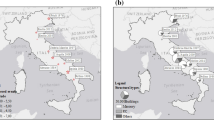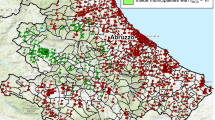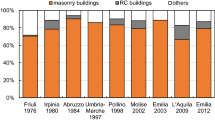Abstract
The study analyses the data related to a database of 7597 private Reinforced Concrete buildings located in the city and the province of L’Aquila surveyed after the 2009 earthquake. Survey data were collected by the Italian Department of Civil Protection during post-earthquake usability inspections including information on building characteristics, level and extent of damage to structural and non-structural components. For each building, the Peak Ground Acceleration demand has been determined according to data available from the ShakeMap of the event and the georeferenced building location. The analysis of data highlights the key role played by the damage to non-structural components—namely, infills and partitions. Damage Grades according to the European Macroseismic Scale EMS-98 have been derived from damage data to single building components. Two building classes have been defined in the study in order to investigate the influence of number of storeys of buildings on the observed damage. Damage Probability Matrices have been derived for the assumed building classes and bins of Peak Ground Acceleration, and observed trends are analyzed. Different methodologies for estimating fragility functions from data on Damage Grades and Peak Ground Acceleration demand are illustrated, discussed and applied to the database, leading to the derivation of EMS-98-based fragility curves for the defined building classes. Finally, the proposed fragility curves are compared with main empirical fragility curves for RC buildings from literature studies.
















Similar content being viewed by others
References
Ambraseys NN, Simpson KA, Bommer JJ (1996) Prediction on horizontal response spectra in Europe. Earthq Eng Struct Dyn 25(4):371–400
Amiri GG, Jalalian M, Amrei SAR (2007) Derivation of vulnerability functions based on observational data for Iran. In: Proceedings of international symposium on innovation and sustainability of structures in civil engineering, Tongji University, China
Baggio C, Bernardini A, Colozza R, Coppari S, Corazza L, Della Bella M, Di Pasquale G, Dolce M, Goretti A, Martinelli A, Orsini G, Papa F, Zuccaro G (2007) Field manual for post-earthquake damage and safety assessment and short term countermeasures (Pinto A, Taucer F eds), Translation from Italian: Goretti A, Rota M, JRC Scientific and technical reports, EUR 22868 EN-2007
Baker JW (2015) Efficient analytical fragility function fitting using dynamic structural analysis. Earthq Spectra 31(1):579–599
Bommer JJ, Elnashai AS, Weir AG (2000) Compatible acceleration and displacement spectra for seismic design codes. In: Proceedings of the 12th world conference on earthquake engineering, Auckland, New Zeland, paper no. 207.2000
Borzi B, Pinho R, Crowley H (2008) Simplified pushover-based vulnerability analysis for large scale assessment of RC buildings. Eng Struct 30(3):804–820
Braga F, Dolce M, Liberatore D (1982) A statistical study on damaged buildings and an ensuing review of the MSK-76 scale. In: Proceedings of the 7th European conference on earthquake engineering, Athens, Greece, pp 431–450
Calvi GM (1999) A displacement-based approach for vulnerability evaluation of classes of buildings. J Earthq Eng 3(3):411–438
CEN (2003) Eurocode 8: design of structures for earthquake resistance—Part 1: general rules, seismic actions and rules for buildings. Comité Européen de Normalisation, Brussels
Cosenza E, Manfredi G, Polese M, Verderame GM (2005) A multi-level approach to the capacity assessment of existing RC buildings. J Earthq Eng 9(1):1–22
Crowley H, Pinho R, Bommer JJ (2004) A probabilistic displacement-based vulnerability assessment procedure for earthquake loss estimation. Bull Earthq Eng 2(2):173–219
De Luca F, Verderame GM, Manfredi G (2015) Analytical versus observational fragilities: the case of Pettino (L’Aquila) damage data database. Bull Earthq Eng 13(4):1161–1181
Del Gaudio C, Ricci P, Verderame GM, Manfredi G (2015) Development and urban-scale application of a simplified method for seismic fragility assessment of RC buildings. Eng Struct 91:40–57. doi:10.1016/j.engstruct.2015.01.031
Del Gaudio C, Ricci P, Verderame GM, Manfredi G (2016) Observed and predicted earthquake damage scenarios: the case study of Pettino (L’Aquila) after the 6th April 2009 event. Bull Earthq Eng. doi:10.1007/s10518-016-9919-2
Di Ludovico M, Prota A, Moroni C, Manfredi G, Dolce M (2016a) a, “Reconstruction process of damaged residential buildings outside the historical centres after L’Aquila earthquake—part I: “light damage” reconstruction. Bull Earthq Eng. doi:10.1007/s10518-016-9877-8
Di Ludovico M, Prota A, Moroni C, Manfredi G, Dolce M (2016b) b. Reconstruction process of damaged residential buildings outside historical centres after the L’aquila earthquake—part II: “heavy damage” reconstruction. Bull Earthq Eng. doi:10.1007/s10518-016-9979-3
Dolce M, Goretti A (2015) Building damage assessment after the 2009 Abruzzi earthquake. Bull Earthq Eng 13(8):2241–2264
Dolce M, Masi A, Goretti A (1999) Damage to buildings due to 1997 Umbria–Marche earthquake. In: Bernardini A (ed) Seismic damage to masonry buildings. Balkema, Rotterdam
Goretti A, Di Pasquale G (2004) Building inspection and damage data for the 2002 Molise, Italy earthquake. Earthq Spectra 20(S1):167–190
Grünthal G (1998) Cahiers du Centre Européen de Géodynamique et de Séismologie: volume 15—European Macroseismic Scale 1998. European Center for Geodynamics and Seismology, Luxembourg
Iervolino I, Manfredi G, Polese M, Verderame GM, Fabbrocino G (2007) Seismic risk of R.C. building classes. Eng Struct 29(5):813–820
Ioannou I, Rossetto T, Grant DN (2012) Use of regression analysis for the construction of empirical fragility curves. In: Proceedings of the 15th world conference on earthquake engineering, September 24––28, Lisbon, Portugal. Paper 2143
ISTAT (2011) 15° Censimento della popolazione e delle abitazioni 2011. Istituto Nazionale di Statistica. http://www.istat.it/it/censimento-popolazione/censimento-popolazione-2011
Lagomarsino G, Giovinazzi S (2006) Macroseismic and mechanical models for the vulnerability and damage assessment of current buildings. Bull Earthq Eng 4:415–443
Liel A, Lynch K (2012) Vulnerability of reinforced-concrete-frame buildings and their occupants in the 2009 L’Aquila, Italy, earthquake. Nat Hazards Rev 13(1):11–23
Margottini C, Molin D, Serva L (1992) Intensity versus ground motion: a new approach using Italian data. Eng Geol 33(1):45–58
Medvedev SV (1977) Seismic Intensity Scale MSK-76. Publication Institute of Geophysics of Poland, Academy of Sciences, Varsaw
Michelini A, Faenza L, Lauciani V, Malagnini L (2008) ShakeMap implementation in Italy. Seismol Res Lett 79(5):688–697
Orsini G (1999) A model for buildings’ vulnerability assessment using the Parameterless Scale of Seismic Intensity (PSI). Earthq Spectra 15(3):463–483
Polese M, Di Ludovico M, Marcolini M, Prota A, Manfredi G (2015) Assessing reparability: simple tools for estimation of costs and performance loss of earthquake damaged reinforced concrete buildings. Earthq Eng Struct Dyn 44(10):1539–1557
Regio Decreto Legge n. 431 del 13/3/1927 (1927) Norme tecniche ed igieniche di edilizia per le località colpite dai terremoti. G.U. n. 82 dell’8/4/1927 (in Italian)
Regio Decreto Legge n. 573 del 29/4/1915 (1915) Che riguarda le norme tecniche ed igieniche da osservarsi per i lavori edilizi nelle località colpite dal terremoto del 13 gennaio 1915. G.U. n. 117 dell’11/5/1915 (in Italian)
Ricci P, De Luca F, Verderame GM (2011) 6th April 2009 L’Aquila earthquake, Italy: reinforced concrete building performance. Bull Earthq Eng 9(1):285–305
Rossetto T (2004) Vulnerability curves for the seismic assessment of reinforced concrete structure populations. PhD Thesis, Imperial College, London, UK
Rossetto T, Elnashai A (2003) Derivation of vulnerability functions for European-type RC structures based on observational data. Eng Struct 25(10):1241–1263
Rossetto T, Ioannou I, Grant DN (2013) Existing empirical fragility and vulnerability functions: compendium and guide for selection. GEM technical report 2013-X, GEM Foundation, Pavia
Rossetto T, Ioannou I, Grant DN, Maqsood T (2014) Guidelines for empirical vulnerability assessment. GEM Technical Report 2014-X, GEM Foundation, Pavia
Rota M, Penna A, Strobbia CL (2008) Processing Italian damage data to derive typological fragility curves. Soil Dyn Earthq Eng 28(10):933–947
Sabetta F, Goretti A, Lucantoni A (1998) Empirical fragility curves from damage surveys and estimated strong ground motion. In: Proceedings of the 11th European conference on earthquake engineering, Paris, France, September 6–11
Sieberg A (1930) Geologie der Erdbeben. Handbuch der Geophysik 2(4):552–555
Singhal A, Kiremidjian AS (1996) Method for probabilistic evaluation of seismic structural damage. ASCE J Struct Eng 122(12):1459–1467
Spence RJS, Coburn AW, Sakai S, Pomonis A (1991) A parameterless scale of seismic intensity for use in the seismic risk analysis and vulnerability assessment. In: International conference on earthquake, blast and impact, Manchester, UK, September 19–20, pp 19–30
Spence RJS, Coburn AW, Pomonis A (1992) Correlation of ground motion with building damage: the definition of a new damage-based seismic intensity scale. In: Proceedings of 10th world conference on earthquake engineering, Balkema, Rotterdam
Verderame G, Iervolino I, Ricci P (2009) Rapporto fotografico dei danni subiti dagli edifici a seguito dell’evento sismico del 6 aprile 2009 ore 1.32 (utc) – aquilano. Available at http://www.reluis.it (in Italian)
Verderame GM, De Luca F, Ricci P, Manfredi G (2011) Preliminary analysis of a soft-storey mechanism after the 2009 L’Aquila. Earthqu Eng Struct Dyn 40:925–944
Verderame GM, Ricci P, De Luca F, Del Gaudio C, De Risi MT (2014) Damage scenarios for RC buildings during the 2012 Emilia (Italy) earthquake. Soil Dyn Earthq Eng 66:385–400
Wald DJ, Worden CB, Quitoriano V, Pankow KL (2006) ShakeMap® Manual, technical manual, users guide, and software guide. http://pubs.usgs.gov/tm/2005/12A01/pdf/508TM12-A1.pdf
Zuccaro G (2004) Progetto SAVE—Task1: inventario e vulnerabilità del patrimonio edilizio residenziale del territorio nazionale, mappe di rischio e perdite socio-economiche. INGV/GNDT (in Italian)
Zuccaro G, Cacace F (2009) Revisione dell’inventario a scala nazionale delle classi tipologiche di vulnerabilità ed aggiornamento delle mappe nazionali di rischio sismico. Atti del XIII Convegno ANIDIS “L’ingegneria sismica in Italia”, June 28–July 2, Bologna, Italy. Paper S14.39 (in Italian)
Zuccaro G, Cacace F (2015) Seismic vulnerability assessment based on typological characteristics. The first level procedure “SAVE”. Soil Dyn Earthq Eng 69:262–269
Author information
Authors and Affiliations
Corresponding author
Rights and permissions
About this article
Cite this article
Del Gaudio, C., De Martino, G., Di Ludovico, M. et al. Empirical fragility curves from damage data on RC buildings after the 2009 L’Aquila earthquake. Bull Earthquake Eng 15, 1425–1450 (2017). https://doi.org/10.1007/s10518-016-0026-1
Received:
Accepted:
Published:
Issue Date:
DOI: https://doi.org/10.1007/s10518-016-0026-1




